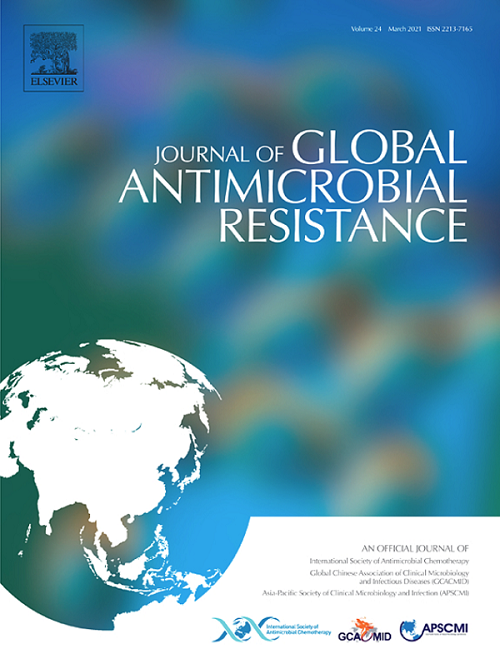发热性尿路感染患儿产esbl肠杆菌氨基糖苷类耐药流行病学及aac(6’)-Ib-cr基因表型检测
IF 3.2
3区 医学
Q2 INFECTIOUS DISEASES
引用次数: 0
摘要
目的:产esbl肠杆菌(ESBL-E)在管理儿童发热性尿路感染(FUTIs)方面提出了越来越大的挑战,使得阿米卡星成为一个很好的概率每日一次和门诊治疗选择。本流行病学研究调查了儿童ESBL-E分离株的氨基糖苷耐药模式,特别关注aac(6')-Ib-cr基因,这是一种常见的耐药决定因素,可提高阿米卡星mic并可能损害其疗效。我们还旨在评估在临床实践中检测aac(6’)-Ib-cr的表型方法。方法:对来自24个中心的251例小儿FUTIs患者的ESBL-E进行研究。所有患者均进行全基因组测序以确定氨基糖苷抗性基因。采用纸片扩散法和e -试验测定药敏。在标准(10^5 CFU/mL)和高(10^7 CFU/mL)接种时测定阿米卡星mic,并根据EUCAST 2024断点进行解释。结果:54.2%的分离株中检出与临床相关的氨基糖苷类耐药基因,但仅有3.6%的分离株对阿米卡星耐药。其中31.1%(78/251)的菌株携带aac(6’)-Ib-cr, 94.9%的菌株与其他氨基糖苷耐药基因共存。含有aac(6')-Ib-cr的菌株显示出更高的阿米卡星mic(中位数为8 mg/L vs 2 mg/L;结论:ESBL-E对阿米卡星的低耐药性支持其继续作为儿童FUTIs的可靠经验性治疗。然而,aac(6’)-Ib-cr基因可以提高阿米卡星mic,尽管EUCAST易感性,但可能会影响高接种量感染的疗效。我们的表型算法有助于检测它并指导儿科FUTIs的治疗决策。本文章由计算机程序翻译,如有差异,请以英文原文为准。
Epidemiology of aminoglycosides resistance and phenotypic detection of aac(6’)-Ib-cr gene in ESBL-producing Enterobacterales in febrile urinary tract infection in children
Objectives
ESBL-producing Enterobacterales (ESBL-E) poses a growing challenge in managing febrile urinary tract infections (FUTIs) in children, leaving amikacin as a good probabilistic once-daily and outpatient treatment option. This epidemiological study investigates aminoglycoside resistance patterns among pediatric ESBL-E isolates, with a particular focus on the aac(6’)-Ib-cr gene—a common resistance determinant that elevates amikacin MICs and may compromise its efficacy. We also aimed to evaluate a phenotypic method to detect aac(6’)-Ib-cr in clinical practice.
Methods
We studied 251 ESBL-E from pediatric FUTIs collected in 24 centers. All underwent whole-genome sequencing to determine aminoglycoside resistance genes. Antimicrobial susceptibility was determined by disk diffusion and E-test. Amikacin MICs were measured at standard (10^5 CFU/mL) and high (10^7 CFU/mL) inocula, and interpreted according to EUCAST 2024 breakpoints.
Results
Clinically relevant aminoglycoside-resistance genes were identified in 54.2% of isolates, although only 3.6% were resistant to amikacin. Among the isolates, 31.1% (78/251) carried aac(6’)-Ib-cr, co-occurring with other aminoglycoside-resistance genes in 94.9% of cases. Strains harboring aac(6’)-Ib-cr displayed higher amikacin MICs (median 8 mg/L vs 2 mg/L; p<0.001) and became resistant at high inoculum. We propose a simple phenotypic algorithm combining “cliff-like” amikacin inhibition-zone edges and tobramycin disk diameters (<16 mm), correctly identifying 99% of our aac(6’)-Ib-cr-positive strains.
Conclusion
The low amikacin resistance in ESBL-E supports its continued use as a reliable empiric treatment for pediatric FUTIs. However, the aac(6’)-Ib-cr gene can raise amikacin MICs, potentially compromising efficacy in high-inoculum infections despite EUCAST susceptibility. Our phenotypic algorithm helps detect it and guide treatment decisions for pediatric FUTIs.
求助全文
通过发布文献求助,成功后即可免费获取论文全文。
去求助
来源期刊

Journal of global antimicrobial resistance
INFECTIOUS DISEASES-PHARMACOLOGY & PHARMACY
CiteScore
8.70
自引率
2.20%
发文量
285
审稿时长
34 weeks
期刊介绍:
The Journal of Global Antimicrobial Resistance (JGAR) is a quarterly online journal run by an international Editorial Board that focuses on the global spread of antibiotic-resistant microbes.
JGAR is a dedicated journal for all professionals working in research, health care, the environment and animal infection control, aiming to track the resistance threat worldwide and provides a single voice devoted to antimicrobial resistance (AMR).
Featuring peer-reviewed and up to date research articles, reviews, short notes and hot topics JGAR covers the key topics related to antibacterial, antiviral, antifungal and antiparasitic resistance.
 求助内容:
求助内容: 应助结果提醒方式:
应助结果提醒方式:


